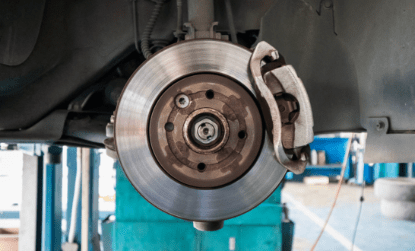Your brakes play a critical role in ensuring your and other peoples’ safety on the road. That’s why paying extra attention to their performance should be among your top maintenance priorities.
A critical component of your braking mechanism is the brake pads—the removable surfaces that calipers use to make contact with the rotors during the process of bringing your vehicle to a stop. When your brake pads are not performing as they should, you’re looking at safety issues, not to mention additional damage to your car if the problem is not promptly addressed.
So pay attention and watch out for these signs of brake pad wear or damage:
1. Squeaks and squeals
Squeaky brakes can be normal in some weather conditions, like rain; they are, however, likely a sign of trouble otherwise. Generally, that squeaking or squealing sound is the first sign that you need to replace your brake pads, and you should promptly have a professional look at them.
2. Clicks
Hear any clicking sound lately whenever you push or release the brake pedal? This is caused by the pads coming loose from the special holding device, or clips, bolts, or pins (depending on the vehicle) that keep them snugly in place. This loosening is often caused by damage to parts of the surrounding hardware and causes the pads to rattle.
3. Longer time to come to a full stop
When this happens, what you’re dealing with is called a brake fade—which is more often directly caused by the intentional application of the brakes over a great distance without bringing the car to a full stop.
While this maneuver may be necessary in some cases (say, when driving down a mountainside or over a winding road), it shouldn’t be your go-to move even if you have to regularly drive downhill, otherwise your braking mechanism will be affected: When the pads are forced to make long, uninterrupted contact with the rotors, both will heat up and end up unable to generate the required amount of friction against each other, resulting in a brake fade.
4. Indicator lights on
Some car models come with a sensor on the bake pad that gets triggered when the brake pads have been worn down, turning on your indicator light. This is good reason to turn to a professional for advice on when to replace your brake pads.
5. Deep, grinding metallic sound
Some brake pads have small metal ridges at the bottom that will make a loud noise when it’s time to replace the pads. That deep, grinding sound is your prompt to take your car to a professional right away. If the metal ridges grind against other metal areas of your tire, you could be looking at a more serious damage that require more extensive repairs and replacements.
6. Brake pedal vibration
A vibrating brake pedal is a sign of possible damage, so get your car checked right away. Difficulty in stopping your car and vibration or the brake pedals feeling unsteadiy when you press down means the pads have worn out.
7. Car nose pulling to one side when you brake
When your car nose starts pulling to one side when you brake, the pads on that side have thinned. This is normal: brake pads won’t always wear out at the exact same rate.
Have your mechanic check the problem at once to avoid putting unnecessary stress on your steering rack (and your vehicle’s ball joints, steering knuckles, and wheel bearings). Two new sets of pads should be installed in one session.
Other than your brake pads, either of these may also be the cause of this particular problem:
- uneven tire pressure
- faulty wheel bearing
- malfunctioning brake caliper
8. Thinning
Don’t forget to also look at your brake pads to determine whether it may be time for new ones. Look between the spokes on your wheels to locate the brake pad on the rotor of the tire. Brake pads that look less than a ¼ inch thick are due for a replacement.
Looking for a car ownership experience that’s big on you peace of mind?
Look no farther than EverCare Protection for superior protection products, robust benefits, and innovative technology.
Call us today to learn about how we can best serve you.

